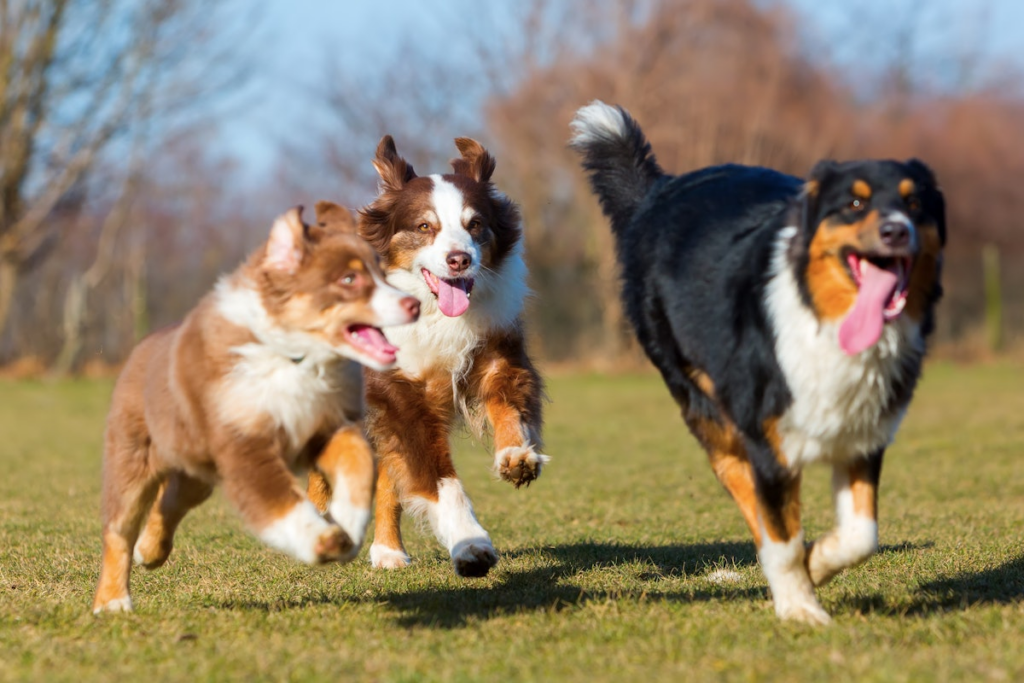While one-on-one walks with your dog can be great for providing exercise and training, they often don’t allow for much interaction with other canines. Meeting fellow dogs is key for pets being able to learn and practice socialization (and, let’s be real, for embarrassing their owners by sniffing every butt they can find), but unless you live on a huge plot of land with endless space for animals to roam free, making that happen probably requires trips to the local dog park.
That’s not a bad thing, of course, as these parks not only allow pups to socialize, but also to burn off steam. “Dogs need exercise to burn calories, stimulate their minds, and stay healthy,” says Corinne Fritzell, a behavior specialist at the American Society for the Prevention of Cruelty to Animals’ (ASPCA) adoption center. “Exercise also tends to help dogs avoid boredom, which can lead to destructive behaviors. Supervised fun and games will satisfy many of your pet’s instinctual urges to dig, herd, chew, retrieve, and chase.”
Yet while dog parks can be a saving grace for this reason, they also can breed drama, considering how many canines (and humans) are packed into one public space. It’s crucial that everyone there is respectful, safe, and responsible, so before you next head over with your pup, brush up on some proper dog park etiquette.
It may be tempting to take your hyper, new puppy to a park right away, but it’s not wise. Kristi Benson, a dog trainer and owner, suggests waiting until your pet is at least five months old before heading to the park, as puppies first need to learn proper socialization in smaller, more controlled environments.
If you want your dog to interact with others but they’re too young, “look for a good puppy class that limits participation to dogs under about four months, allows a lot of free play and is taught by a trainer who only uses positive reinforcement,” Benson advises.
Once your dog is old enough to go to the park, try it out first on a practice run. Fritzell recommends visiting during an off time when it’s not too crowded, and keep your time there “short and sweet.”
To gage whether or not your dog is comfortable being at the park, look for “relaxed body language, [such as] a loosely wagging tail, no physical tension, and maybe even a play bow," says Fritzell. If your pup crouches close to the ground, pins their ears back, hides behind you, snarls, or exhibits a “low or tucked tail, raised hair, a hunched back,” she adds, it’s best to hold off on the park until you’ve done a few more trials, as it might indicate that they’ll be aggressive or stressed out around other dogs.
And this doesn’t only apply to puppies. If you recently adopted an adult dog, take the same gradual approach and give your pet time to adjust and get comfortable before diving into potentially chaotic park play.
Some large dogs can act predatory toward smaller ones, which can lead to injuries and altercations. If you have a young or tiny dog, introduce them slowly to larger animals, but only after you’ve confirmed with the owners that the dogs are calm and gentle around smaller pets. “Most puppies will benefit from continuing with this style of select dog interactions until they are a little older and more confident, as negative interactions with other dogs during this sensitive time can lead to lasting issues,” explains Benson.
Additionally, keep your small dog away from animals that’ve just arrived into the park to avoid potential incidents. “When new visitors enter the area, call your furry friend over and give the newcomers a chance to get settled before your pet greets them,” says Fritzell.
If you have a big dog yourself, be respectful and only bring them to parks that are appropriate for their size — and separate them from smaller pets they could potentially hurt. Ideally, dogs should only be in a dog park with dogs who are similar in size or bigger, says Benson. Many dog parks have separate areas for different size animals.
According to Frtizell, some cities and parks require all dogs to be up-to-date on vaccinations and be officially licensed in order to join in the fun. But even if there isn’t an official policy at your local park, you should make sure your dog is vaccinated and healthy before going.
“Dog parks can be a haven for illness and infection,” says Lauren McDevitt, co-founder of dog adoption company Good Dog. Even if your pet is healthy, she explains, they could still come in contact with dogs who are suffering from potentially contagious things like ticks or fleas, so doing what you can beforehand to prevent the spread of illness is crucial.
Additionally, check that your dog is free of any injuries. "Health conditions can instigate dog fights, as dogs in pain can quickly become aggressive," explains McDevitt.
Letting your dog off their leash in the park isn’t just a nice way to let them have their freedom — it’s actually important for their safety. “Dogs should never be left on a leash in a dog park, as it can prevent them from moving away from other animals and cause a feeling of being trapped," explains Fritzell. "This could lead to aggressive or defensive behavior."
McDevitt recommends having a slip lead leash (often used to help dogs focus during training) at the ready, “so you can quickly loop it around your dog’s neck and remove him” if you notice any unwanted behavior.
If your dog isn’t good being off-leash, then the park probably isn’t the best place for them.
Some dog parks prohibit owners bringing in any food or treats, and for good reason. “Your dog might be well-behaved around food, but this could bring out food-aggression in other dogs or even start a fight,” explains McDevitt.
In addition, other dogs in the park may be allergic to the food you bring in, so if you do bring treats, only give them to your dog when there aren’t others close by — and ask your fellow owners before offering anything to their pets. Once the food is given, “be prepared for other dogs to sniff out your treats and jump or follow you around,” Fritzell says.
But while food should be limited at dog parks, "it’s key to make sure your canine has access to clean, fresh water at all times,” McDevitt says. She recommends bringing a collapsible bowl and bottled water instead of using the communal water bowl offered by some parks, in order to avoid the spread of illness.
Dog parks are public spaces, so it’s important to clean up after both yourself and your pet. Don’t leave things like food wrappers, water bottles, or defunct toys lying around after you leave. And just as you would do on your walks around the block, pick up any pet waste right away to keep the park clean and prevent people or other dogs from stepping in it.
That means paying attention to your dog at all times. “Dog owners who aren’t supervising their pets won’t quickly be able to clean up after their them," notes McDevitt. This leads us to our next point.
“While it’s tempting to catch up on emails or read while your dog plays," says McDevitt, being distracted could make you miss your dog or another person’s pet displaying worrisome signs of aggression. "If you’re watching your dog closely, you’ll be able to step in and prevent a fight before it escalates," she explains.
That’s not to say you can’t socialize with other owners or check your phone at all while at the park, but your priority should be watching on your dog — and knowing their body language and cues, whether they’re signifying aggression, hunger, discomfort, or fatigue.
Unfortunately, just because you’re on alert, it it doesn’t mean other owners are doing the same. “If there are a lot of people talking and not paying attention to their dogs or on their phones, proceed with caution, as warning signals may be missed,” Fritzell says.
If your dog is caught in a fight, Benson suggests first yelling at them, but if that has no effect, "head toward the fight and grab your dog at the hips and lift his hips up into the air until he is in a hand-stand on his front feet. This will feel terrifying, but a dog being held at the hips like this can’t reach around to bite you.”
Benson advises telling the other owner to do the same with their dog — respectfully, of course — and working together to pull the dogs apart. However, “if the owner is unwilling to correct their own dog’s inappropriate behavior, it’s best to leave and be polite rather than accelerate the altercation," says McDevitt.
Similarly, if you witness a fight involving other people’s dogs that’s getting you nervous, "it’s OK to step in and remove your dog or yourself from the situation,” she adds.
Dog parks offer space and opportunity for fun playtime — but keep in mind, the park isn’t your personal backyard, so not all games are suitable. If you want to play fetch, for instance, pay close attention to both your dog’s behavior and that of other pets nearby.
"If your dog is snarly about other dogs approaching his ball, head to a part of the park with no other dogs, or find another place to play fetch," says Benson. "If another dog is snarly about your dog’s ball, the same advice applies: It’s your job to play fetch elsewhere here. You’re at a dog park, not a fetch park.”

